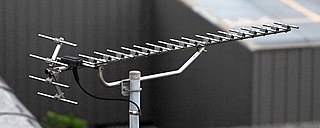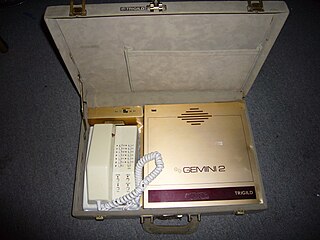
Advanced Mobile Phone System (AMPS) was an analog mobile phone system standard originally developed by Bell Labs and later modified in a cooperative effort between Bell Labs and Motorola. It was officially introduced in the Americas on October 13, 1983, Israel in 1986, Australia in 1987, Singapore in 1988, and Pakistan in 1990. It was the primary analog mobile phone system in North America through the 1980s and into the 2000s. As of February 18, 2008, carriers in the United States were no longer required to support AMPS and companies such as AT&T and Verizon Communications have discontinued this service permanently. AMPS was discontinued in Australia in September 2000, in Pakistan by October 2004, in Israel by January 2010, and Brazil by 2010.

In telecommunications, a repeater is an electronic device that receives a signal and retransmits it. Repeaters are used to extend transmissions so that the signal can cover longer distances or be received on the other side of an obstruction. Some types of repeaters broadcast an identical signal, but alter its method of transmission, for example, on another frequency or baud rate.
In telecommunications and computer networks, a channel access method or multiple access method allows more than two terminals connected to the same transmission medium to transmit over it and to share its capacity. Examples of shared physical media are wireless networks, bus networks, ring networks and point-to-point links operating in half-duplex mode.

A communication channel refers either to a physical transmission medium such as a wire, or to a logical connection over a multiplexed medium such as a radio channel in telecommunications and computer networking. A channel is used to convey an information signal, for example a digital bit stream, from one or several senders to one or several receivers. A channel has a certain capacity for transmitting information, often measured by its bandwidth in Hz or its data rate in bits per second.

Ultra high frequency (UHF) is the ITU designation for radio frequencies in the range between 300 megahertz (MHz) and 3 gigahertz (GHz), also known as the decimetre band as the wavelengths range from one meter to one tenth of a meter. Radio waves with frequencies above the UHF band fall into the super-high frequency (SHF) or microwave frequency range. Lower frequency signals fall into the VHF or lower bands. UHF radio waves propagate mainly by line of sight; they are blocked by hills and large buildings although the transmission through building walls is strong enough for indoor reception. They are used for television broadcasting, cell phones, satellite communication including GPS, personal radio services including Wi-Fi and Bluetooth, walkie-talkies, cordless phones, and numerous other applications.

Interim Standard 95 (IS-95) was the first ever CDMA-based digital cellular technology. It was developed by Qualcomm and later adopted as a standard by the Telecommunications Industry Association in TIA/EIA/IS-95 release published in 1995. The proprietary name for IS-95 is cdmaOne.

A pager is a wireless telecommunications device that receives and displays alphanumeric or voice messages. One-way pagers can only receive messages, while response pagers and two-way pagers can also acknowledge, reply to and originate messages using an internal transmitter.
IS-54 and IS-136 are second-generation (2G) mobile phone systems, known as Digital AMPS (D-AMPS), and a further development of the North American 1G mobile system Advanced Mobile Phone System (AMPS). It was once prevalent throughout the Americas, particularly in the United States and Canada since the first commercial network was deployed in 1993. D-AMPS is considered end-of-life, and existing networks have mostly been replaced by GSM/GPRS or CDMA2000 technologies.

A cell site, cell tower, or cellular base station is a cellular-enabled mobile device site where antennas and electronic communications equipment are placed—typically on a radio mast, tower, or other raised structure—to create a cell in a cellular network. The raised structure typically supports antenna and one or more sets of transmitter/receivers transceivers, digital signal processors, control electronics, a GPS receiver for timing, primary and backup electrical power sources, and sheltering.
The radio spectrum is the part of the electromagnetic spectrum with frequencies from 30 Hz to 300 GHz. Electromagnetic waves in this frequency range, called radio waves, are widely used in modern technology, particularly in telecommunication. To prevent interference between different users, the generation and transmission of radio waves is strictly regulated by national laws, coordinated by an international body, the International Telecommunication Union (ITU).

A cellular network or mobile network is a communication network where the link to and from end nodes is wireless. The network is distributed over land areas called "cells", each served by at least one fixed-location transceiver. These base stations provide the cell with the network coverage which can be used for transmission of voice, data, and other types of content. A cell typically uses a different set of frequencies from neighboring cells, to avoid interference and provide guaranteed service quality within each cell.

A car phone is a mobile radio telephone specifically designed for and fitted into an automobile. This service originated with the Bell System, and was first used in St. Louis on June 17, 1946.

Evolution-Data Optimized is a telecommunications standard for the wireless transmission of data through radio signals, typically for broadband Internet access. EV-DO is an evolution of the CDMA2000 (IS-2000) standard which supports high data rates and can be deployed alongside a wireless carrier's voice services. It uses advanced multiplexing techniques including code-division multiple access (CDMA) as well as time-division multiplexing (TDM) to maximize throughput. It is a part of the CDMA2000 family of standards and has been adopted by many mobile phone service providers around the world particularly those previously employing CDMA networks. It is also used on the Globalstar satellite phone network.

The Improved Mobile Telephone Service (IMTS) was a pre-cellular VHF/UHF radio system which linked to the public telephone network. IMTS was the radiotelephone equivalent of land dial phone service. Introduced in 1964, it replaced Mobile Telephone Service (MTS) and improved on most MTS systems by offering direct-dial rather than connections through a live operator, and full-duplex operation so both parties could talk at the same time.

The history of mobile phones covers mobile communication devices that connect wirelessly to the public switched telephone network.
This article discusses the mobile cellular network aspect of teletraffic measurements. Mobile radio networks have traffic issues that do not arise in connection with the fixed line PSTN. Important aspects of cellular traffic include: quality of service targets, traffic capacity and cell size, spectral efficiency and sectorization, traffic capacity versus coverage, and channel holding time analysis.
The Mobile Telephone Service (MTS) was a pre-cellular VHF radio system that linked to the Public Switched Telephone Network (PSTN). MTS was the radiotelephone equivalent of land dial phone service.
CT2 is a cordless telephony standard that was used in the early 1990s to provide short-range proto-mobile phone service in some countries in Europe. It is considered the precursor to the more successful DECT system. CT2 was also referred to by its marketing name, Telepoint.

Radio is the technology of signaling and communicating using radio waves. Radio waves are electromagnetic waves of frequency between 30 hertz (Hz) and 300 gigahertz (GHz). They are generated by an electronic device called a transmitter connected to an antenna which radiates the waves, and received by another antenna connected to a radio receiver. Radio is very widely used in modern technology, in radio communication, radar, radio navigation, remote control, remote sensing, and other applications.
In cellular telecommunications, handover, or handoff, is the process of transferring an ongoing call or data session from one channel connected to the core network to another channel. In satellite communications it is the process of transferring satellite control responsibility from one earth station to another without loss or interruption of service.












